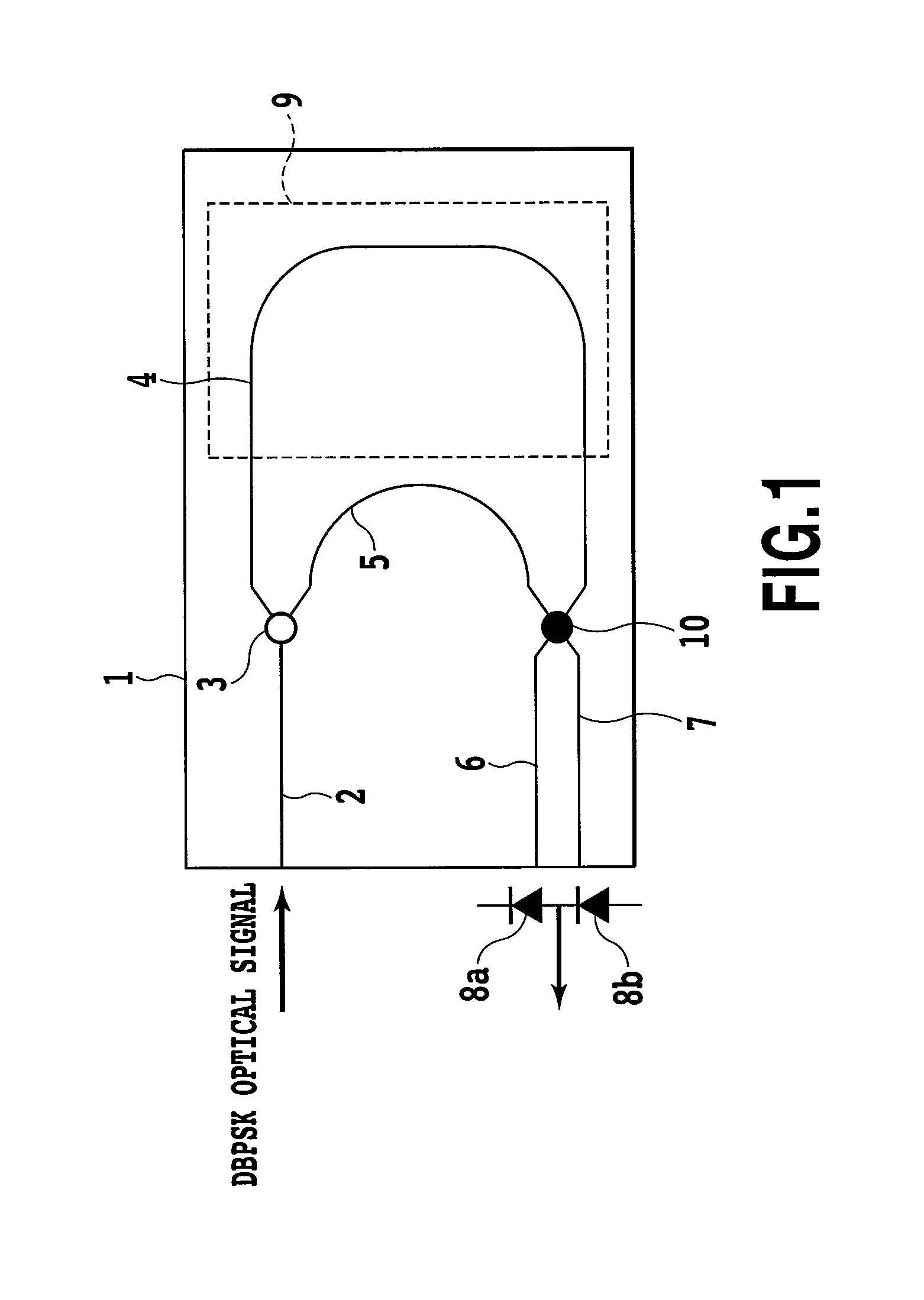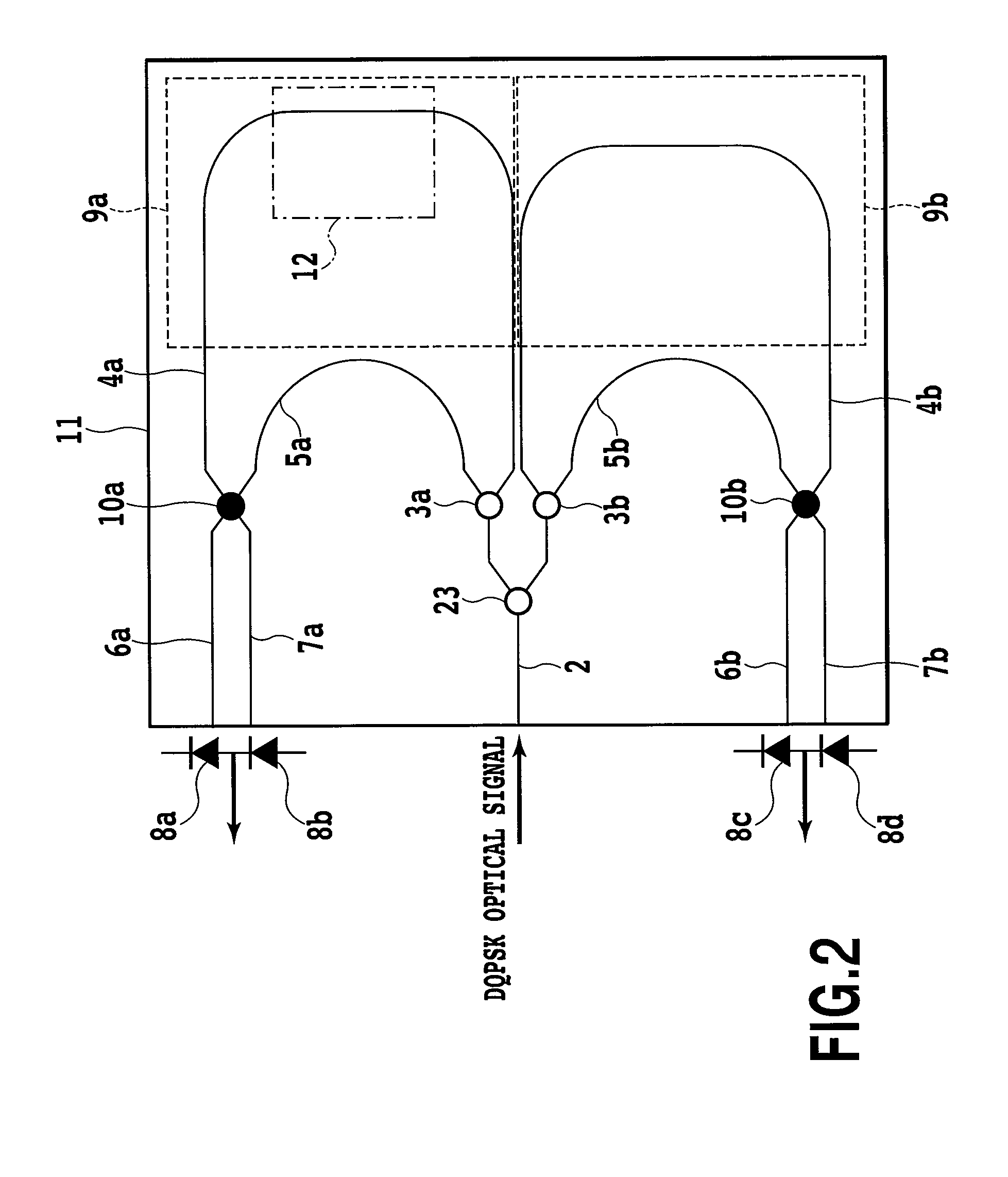Optical delay line interferometer
a technology of optical delay line and interferometer, which is applied in the direction of optical elements, optical waveguide light guides, instruments, etc., can solve the problems of significant degradation of the s/n ratio of demodulated signals, achieve the reduction of polarization dependence and temperature eliminate the polarization dependence of optical delay line interferometer, resulting from birefringence and polarization coupling.
- Summary
- Abstract
- Description
- Claims
- Application Information
AI Technical Summary
Benefits of technology
Problems solved by technology
Method used
Image
Examples
first embodiment
[0129]FIG. 14 shows a schematic diagram of an optical delay line interferometer according to the first embodiment, fabricated actually. The PLC technology is used for fabrication of the optical delay line interferometer. Specifically, flame hydrolysis deposition and reactive ion etching are used to fabricate a silica glass waveguide on a silicon substrate. A core is 4.5 μm square in cross section, and a relative refractive-index difference is 1.5%. Overcladding glass of 30 μm thick is deposited to bury the core.
[0130]After deposition of the overcladding glass, a groove is formed by removing the cladding and the core in a portion of the long arm waveguide, using the reactive ion etching, and the formed groove is filled with the temperature compensation material. In the first embodiment, a silicone resin is used as the temperature compensation material; however, the present invention is not so limited, and, of course, a polymer material or the like may be used. The grooves 14a and 14b...
second embodiment
[0146]Two pairs of optical signals outputted from the optical delay line interferometer in the modulator for an optical multilevel differential phase shift keyed signal are demodulated by photoelectric converters (or the pair of balanced PDs). On this occasion, if there is an arrival time difference (or a skew) between the optical signals reaching the photoelectric converters, the optical signals are converted into electric signals at different times, and thus, demodulation distortion occurs at the time of phase demodulation. This has a great influence particularly on multileveled modulation with constellation points in close proximity to each other, which is not desirable for the demodulator. In order to compensate for the arrival time of the optical signals, a skew adjuster that adjusts the output timing of the optical signals may be placed at the output end of the optical delay line interferometer.
[0147]FIG. 22 is a block diagram of the optical delay line interferometer for DQPSK...
third embodiment
[0151]The embodiments described above are designed focusing on the elimination of the PDf caused by the birefringence and the elimination of the temperature dependence. Description will be given of an embodiment of the circuit configuration further capable of suppressing PDf deterioration caused by the polarization coupling, according to another aspect of the optical delay line interferometer of the present invention. Referring to this embodiment, description will be given of the circuit configuration designed to suppress the PDf by removing produced polarization coupling-induced light, not by suppressing the production in itself of polarization coupling-induced light.
[0152]In order to suppress the PDf caused by the polarization coupling, the simplest measurement is to suppress the production in itself of the polarization coupling-induced light that is the cause of the PDf deterioration. However, the suppression of the polarization coupling is very difficult. The polarization coupli...
PUM
| Property | Measurement | Unit |
|---|---|---|
| delay time | aaaaa | aaaaa |
| refractive index | aaaaa | aaaaa |
| refractive index | aaaaa | aaaaa |
Abstract
Description
Claims
Application Information
 Login to View More
Login to View More - R&D
- Intellectual Property
- Life Sciences
- Materials
- Tech Scout
- Unparalleled Data Quality
- Higher Quality Content
- 60% Fewer Hallucinations
Browse by: Latest US Patents, China's latest patents, Technical Efficacy Thesaurus, Application Domain, Technology Topic, Popular Technical Reports.
© 2025 PatSnap. All rights reserved.Legal|Privacy policy|Modern Slavery Act Transparency Statement|Sitemap|About US| Contact US: help@patsnap.com



